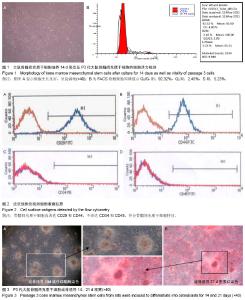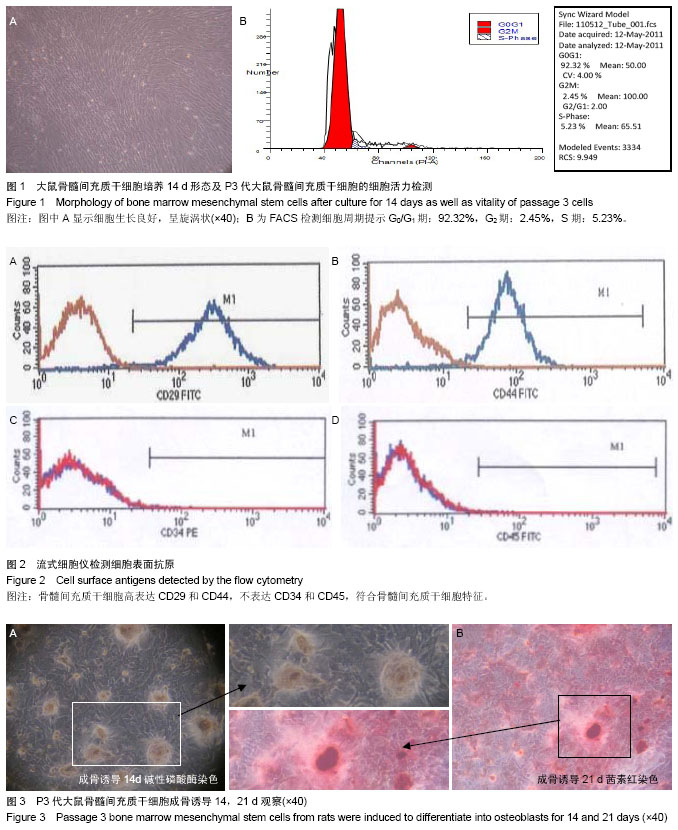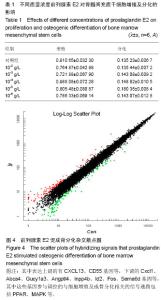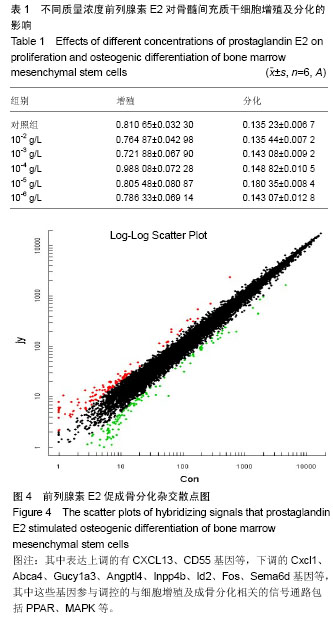| [1] Bu LX, Wang YH , Li NY, et al. Construction of tissue engineering bone with bone marrow stromal cell sheets.Zhonghua Kou Qiang Yi Xue Za Zhi. 2011;46(12): 747-750.
[2] Ma D, Ren L, Liu Y, et al. Engineering scaffold-free bone tissue using bone marrow stromal cell sheets.J Orthop Res. 2010;28(5):697-702.
[3] Lubis AM, Sandhow L, Lubis VK,et al. Isolation and cultivation of mesenchymal stem cells from iliac crest bone marrow for further cartilage defect management.Acta Med Indones. 2011; 43(3):178-184.
[4] Hong D,Che HX, Ge RS, et al. Gen etically Enginee red Mesenchymal Stem Cells: The Ongoing Research for Bone Tissue Engineering.The Anatomical Record. 2010;293(3): 531-537.
[5] 寿培舜,黄寅,苏娟娟,等. 间充质干细胞免疫抑制机制及在疾病中的应用[J]. 细胞生物学杂志,2009,31(1):15-20.
[6] 王建军,樊艳,马爱群,等. 人脂肪间充质干细胞的免疫调节作用[J]. 中国组织工程研究,2012,16(45):8430-8434.
[7] Weinreb M,Suponitzky I,Keila S.Systemic administration of an anabolic dose of PGE2 in young rats increases the osteogenic capacity of bone marrow.Bone.1997;20(6): 521-526.
[8] 王欢,查振刚. 前列腺素E2在骨形成过程中的作用机制[J]. 广东医学,2012,33(11):1683-1685.
[9] Parodi A L. Ethical issue in animal experimentation. Bulletin de l'Académie nationale de médecine.2009;193(8):1737.
[10] Tare RS, Mitchell PD, Kanczler J, et al. Isolation, differentiation, and characterisation of skeletal stem cells from human bone marrow in vitro and in vivo.Methods Mol Biol. 2012; 816:83-99.
[11] Nadri S, Soleimani M, Hosseni RH, et al. An efficient method for isolation of murine bone marrow mesenchymal stem cells. Int J Dev Biol.2007;51(8):723-729.
[12] Guo KT, SchAfer R, Paul A, et al. A new technique for the isolation and surface immobilization of mesenchymal stem cells from whole bone marrow using high-specific DNA aptamers.Stem Cells. 2006;24(10):2220-2231.
[13] Melody Baddoo,Katy Hill,Robin Wilk inson, et al. Characterization of Mesenchymal Stem Cells Isolated From Murine Bone Marrow by Negative Selection.Journal of Cellular Biochemis try. 2003;89(6):1235-1249.
[14] Bhardwaj N, Kundu SC.Chondrogenic differentiation of rat MSCs on porous scaffolds of silk fibroin/chitosan blends. Biomaterials.2012;33(10):2848-2857.
[15] Qian SW, Li X, Zhang YY,et al. Characterization of adipocyte differentiation from human mesenchymal stem cells in bone marrow. BMC Dev Biol.2010;10(1):47.
[16] Pikir BS, Susilowati H, Hendrianto E, et al. Reversin Increase the Plasticity of Bone Marrow-derived Mesenchymal Stem Cell for Generation of Cardiomyocyte in Vitro.Acta Med Indones. 2012;44(1):23-27.
[17] Sargent JM. The use of the MTT assay to study drug resistance in fresh tumour samples.Recent Results Cancer Res.2003;161:13-25.
[18] Orimo H. The mechanism of mineralization and the role of alkaline phosphatase in health and disease.J Nihon Med Sch.2010;77(1):4-12.
[19] Han AJ, Xiong M.Gene chip technology and its advances in medical science.Zhongguo Yi Xue Ke Xue Yuan Xue Bao. 2001;23(5):528-531.
[20] Yoshida K, Oida H, Kobayashi T, et al. Stimulation of bone formation and prevention of bone loss by prostaglandin E EP4 receptor activation. Proc Natl Acad Sci. 2000;99(7):4580- 4585.
[21] Ke HZ, Crawford DT, Qi H, et al. A nonprostanoid EP4 receptor selective prostaglandin E2 agonist restores bone mass and strength in aged, ovariectomized rats. J Bone Miner Res. 2006;21(4):565-575.
[22] Marui A, Hirose K, Maruyama T, et al. Prostaglandin E2 EP4 receptor-selective agonist facilitates sternal healing after harvesting bilateral internal thoracic arteries in diabetic rats. J Thorac Cardiovasc Surg. 2006;131(3):587-593.
[23] Ramirez-Yañez GO, Seymour GJ, Walsh LJ, et al. Prostaglandin E2 enhances alveolar bone formation in the rat mandible. Bone. 2004;35(6):1361-1368.
[24] 权金星,王宝利,郑纺,等. 前列腺素E2调节成骨细胞核因子-κB受体激活物配基和护骨素表达的信号通路研究[J]. 中华医学杂志,2008,88(28):1992-1996.
[25] Norihiko K, Urara H, Nobuyuki M, et al. Nanogel-Based Delivery System Enhances PGE2 Effects on Bone Formation. Journal of Cellular Biochemistry.2007;101(5):1063–1070.
[26] Kaczmarek, MM, Blitek A, Kaminska K, et al. Assessment of VEGF-receptor system expression in the porcine endometrial stromal cells in response to insulin-like growth factor-I, relaxin,oxytocin and prostaglandin E-2. Mol Cell Endocrinol. 2008;291(1-2):33-41.
[27] Benjamin JF, Rebecca LP, Benjamin JG, et al. In vivo prostaglandin E2 treatment alters the bone marrow microenvironment and preferentially expands short-term hematopoietic stem cells. Blood.2009;114(17):4054-4063.
[28] Klein DC, Raisz LG.Prostaglandins: stimulation of bone resorption in tissue culture.Endocrinology.1970;86(6): 1436-1440.
[29] Somayaji SN, Ritchie S, Sahraei M, et al. Staphylococcus aureus induces expression of receptor activator of NF-kappaB ligand and prostaglandin E2 in infected murine osteoblasts.Infect Immun.2008;76(11):5120-5126.
[30] 权金星,王宝利,郑纺,等.前列腺素E2调节大鼠成骨细胞OCIL基因表达的信号通路研究[J].中华内分泌代谢杂志,2011,27(8): 683-686.
[31] 王乐禹,胡晓芳,欧阳钧,等. 前列腺素E2对MC3T3-E1成骨细胞基因表达谱的影响[J]. 中华创伤杂志,2011,27(8):746-751.
[32] Ozyurek A,Leblebicioglu G,Bilgili H,et al.Effects of vascular bundle implantation on autogreft,fresh-frozen allograft,and xenograff incorporation in a rabbit model. Orthopedics. 2008; 31(2):135.
[33] 郑先念,刘金舟,刘洋,等. 前列腺素E2复合同种异体骨治疗实验性骨缺损[J].中国组织工程研究与临床康复,2009,13(41): 8092-8096.
[34] 道书艳,郭葆玉.趋化因子CXCL13及其受体CXCR5研究进展[J].国外医学分子生物学分册, 2003,25(4):200-203.
[35] 王燕,李宝,李玉坤.PPARγ与骨重建研究进展[J].生物医学工程, 2011,28(1):213-216. |



